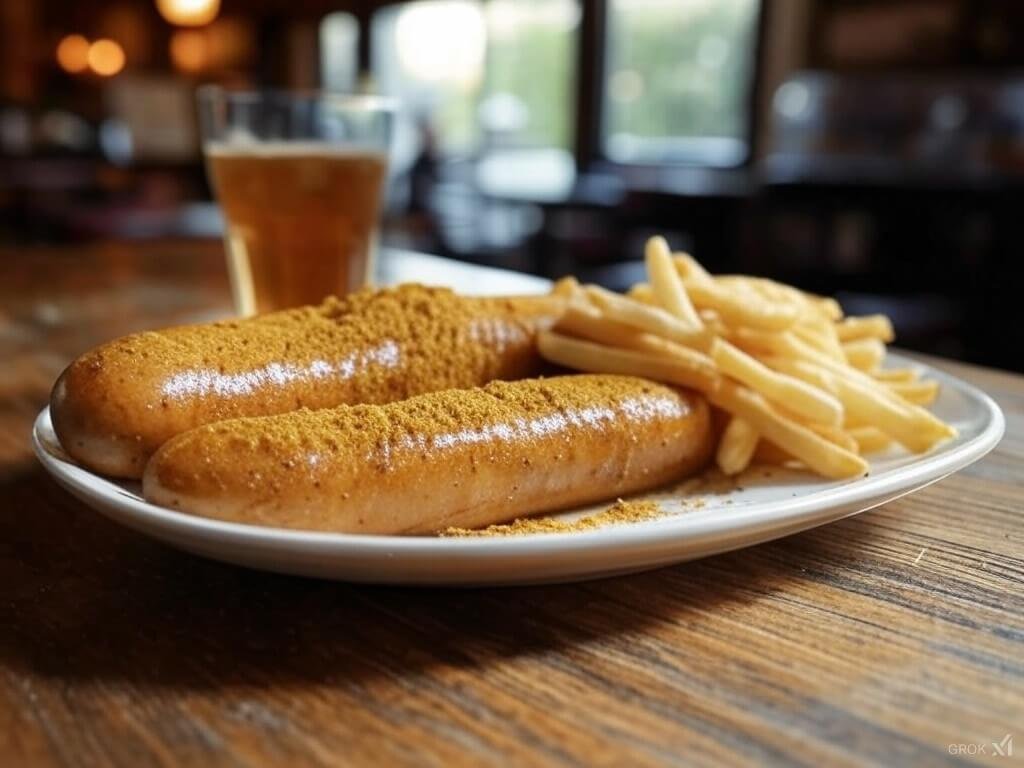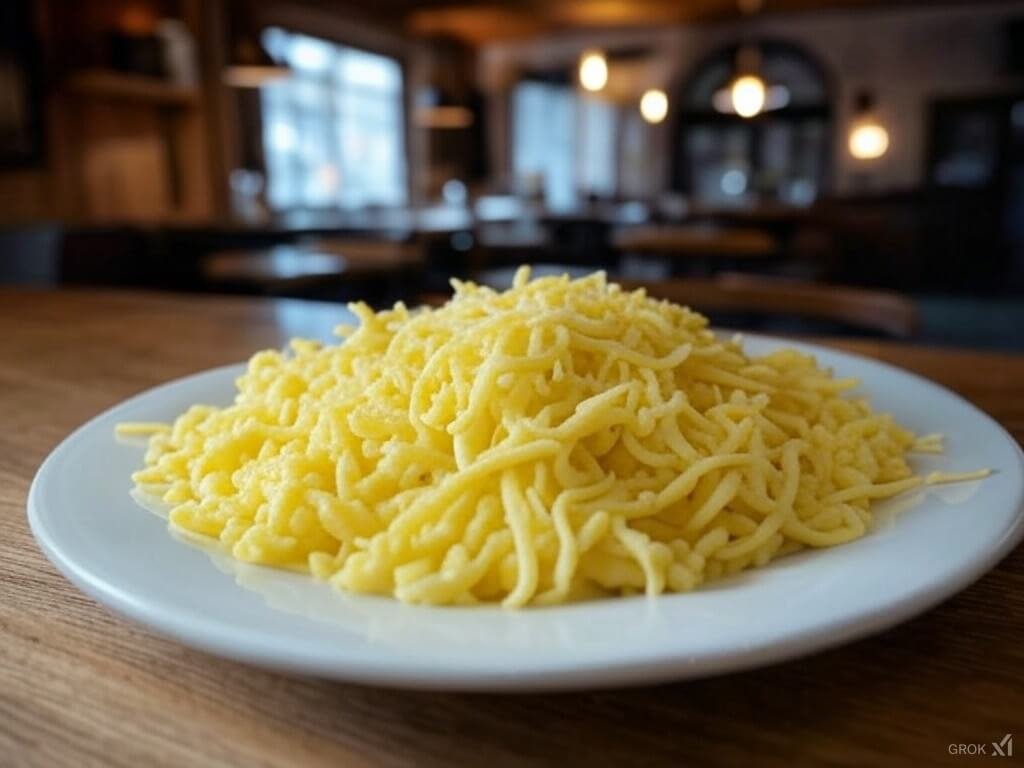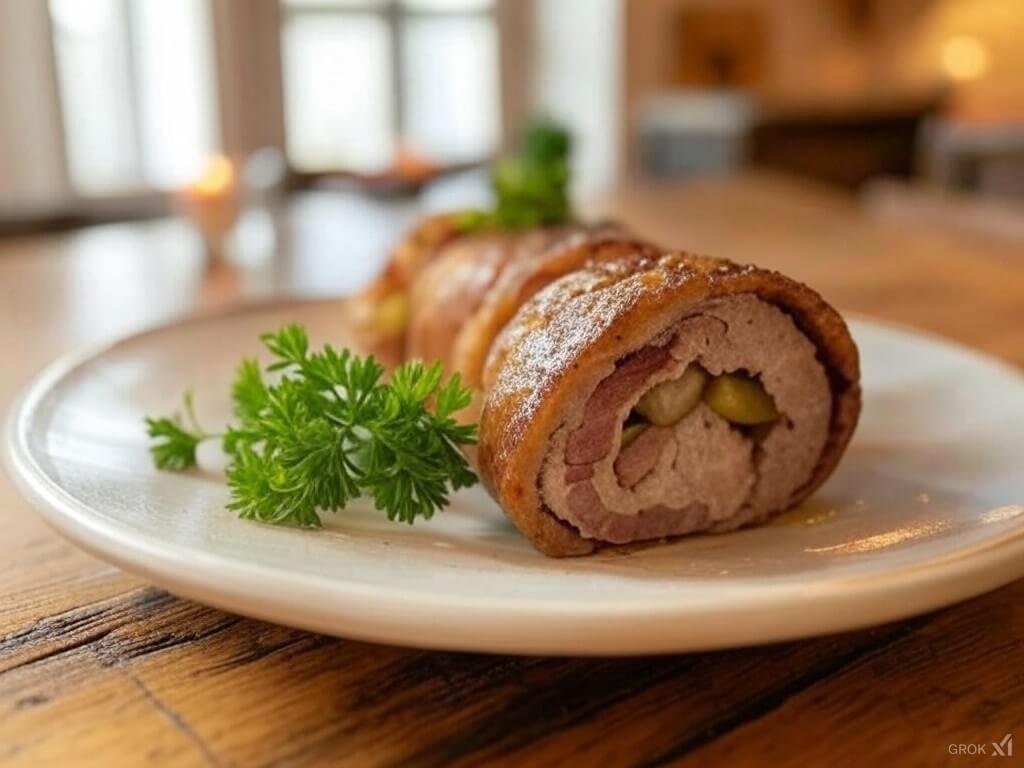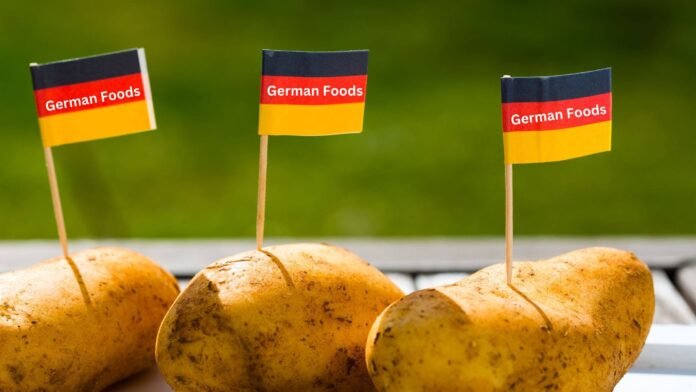Discover 10 mouthwatering German foods you absolutely must try! From hearty sausages to sweet treats, explore the best German cuisine and find your new favorites.
Introduction: A Culinary Journey Through Germany
Have you ever wondered what makes German food so irresistible? Beyond the beer gardens and fairytale castles, Germany offers a rich and diverse culinary landscape filled with bold flavors, comforting dishes, and centuries-old traditions.
From the hearty stews of Bavaria to the delicate seafood of the north, every region brings its twist to classic recipes. Influenced by history and local ingredients, German cuisine is satisfying and deeply rooted in culture. Expect robust meats, fresh-baked bread, and indulgent desserts that leave you craving more.
This guide will take you on a flavorful journey through 10 must-try German foods. Whether you love savory dishes or have a sweet tooth, this list ensures a well-rounded taste of Germany. Get ready to discover flavors that will make you want to book your next trip—or at least your next meal—immediately!
1. Bratwurst – The Classic German Sausage

Bratwurst is a famous German sausage loved for its rich, smoky flavor and juicy texture. Made primarily from pork, though sometimes beef or veal, it is seasoned with a blend of nutmeg, ginger, and marjoram. The sausage is traditionally grilled, pan-fried, or simmered in beer before serving.
There are over 40 regional variations of bratwurst in Germany. The Nürnberger Rostbratwurst is small, thin, and served in sets of six or more with sauerkraut. The Thüringer Bratwurst is longer, spicier, and has a distinctive herbal kick. Each region puts its twist on this iconic dish, making it a staple at street food stalls, beer gardens, and home kitchens.
Taste Profile
Bratwurst has a juicy, slightly smoky, and savory taste with a well-balanced blend of spices. The outer casing turns crisp when grilled, giving a satisfying snap with each bite. The spice intensity and texture can vary from mild and smooth to bold and coarse, depending on the region.
Where to Find It
Bratwurst is everywhere in Germany. You’ll find it at:
- Street food stalls and Christmas markets – Served in a crusty bread roll (Brötchen) with mustard.
- Beer gardens – Paired with pretzels and beer.
- Local butcher shops (Metzgerei) – Offering fresh, high-quality varieties.
- Famous spots: Nürnberger Rostbratwurst in Nuremberg, Thüringer Bratwurst in Thuringia, and Currywurst stands in Berlin (a unique twist with curry ketchup).
Pairing Suggestions
- Best enjoyed with a cold German beer, like a Pilsner or Hefeweizen.
- Sauerkraut or potato salad for a traditional touch.
- Mustard (Senf) – Choose between spicy Düsseldorf or mild Bavarian sweet mustard.
- Pretzels or fresh-baked bread for a hearty meal.
Bratwurst is more than just a sausage—it’s an essential part of German culture and a must-try for any food lover!
Best Places to Try:
- Nuremberg (Nürnberger Bratwurst)
- Thuringia (Thüringer Rostbratwurst)
- Bavaria (Weisswurst)
2. Sauerkraut – The Perfect Tangy Side Dish

Sauerkraut, meaning “so” r cabbage”I” German, is a fermented cabbage dish that has been a staple in German cuisine for centuries. It is made by finely shredding white cabbage and fermenting it with salt, promoting the growth of beneficial probiotics. This process gives sauerkraut its signature tangy flavor and makes it a nutrient-rich and gut-friendly addition to meals.
While it is enjoyed across Germany, variations exist. Bavarian sauerkraut is often milder and slightly sweet, as it’it’soked with caraway seeds, apples, or white wine. Northern German versions tend to be sharper and more acidic. Sauerkraut is not just a side dish—it’it’ssymbol of German culinary heritage and is often paired with meats, especially sausages.
Taste Profile
Sauerkraut has a tangy, slightly sour, and crisp taste with a mild saltiness. The fermentation process gives it a unique depth of flavor, with some versions adding a hint of sweetness or spice.
Where to Find It
- Traditional German restaurants often serve sausages, pork, or Schnitzel alongside.
- Street food stalls – As a topping for bratwurst in a bread roll.
- Supermarkets and markets – Available fresh or in jars.
- Bavarian beer halls – Served warm with hearty meat dishes.
Pairing Suggestions
- Drinks: Pairs well with German beer (Pilsner or Lager) or a crisp Riesling white wine.
- Bratwurst, Weisswurst, or Frankfurters.
- Schweinshaxe (pork knuckle) for an actual Bavarian experience.
- Kassler (smoked pork chops) for a smoky, salty contrast.
- Other Sides: Try it with mashed potatoes or bread dumplings (Semmelknödel) to balance the acidity.
Sauerkraut is more than just a side dish—it’s flavor-packed, health-boosting must-try for anyone exploring German food!
3. Pretzels – The Iconic German Snack

The German Brezel (Pretzel) is one of the country’s most beloved snacks. Characterized by their crispy golden-brown crust, soft, chewy insides, and distinctive knot shape, pretzels are a staple in German bakeries, beer halls, and street food stalls.
Made from simple ingredients—flour, water, yeast, and salt—the dough is dipped in lye before baking, which gives it its unique texture and deep brown color. Bavarian pretzels are more extensive and softer, while Swabian versions are thinner with crispier arms and a fluffier center.
Pretzels have been part of German culture for centuries, dating back to medieval monasteries. They symbolize luck and prosperity traditionally, making them a popular treat during Oktoberfest and New Year celebrations.
Taste Profile
Pretzels have a salty, slightly malty flavor, a crunchy exterior, and a soft, airy inside. When fresh, they have a subtle yeastiness and a satisfying chewiness.
Where to Find It
- Bakeries (Bäckerei) – Every German bakery sells freshly baked Brezeln.
- Beer Gardens (Biergärten) – Served warm with butter or mustard.
- Street Stalls & Oktoberfest – Often sold as a snack with beer.
- Supermarkets – Packaged versions are available but lack the freshness of bakery-made pretzels.
Pairing Suggestions
- Drinks: This is best enjoyed with a cold Bavarian beer, like Weißbier (wheat beer) or Helles (lager).
- Butter (Butterbrezel): A Bavarian classic—pretzel sliced and spread with butter.
- Obatzda: A creamy, spiced cheese spread popular in Bavaria.
- Mustard (Senf): Especially with pretzels served alongside sausages.
- Side Dishes: Often paired with Weißwurst (white sausage) and sweet mustard for an actual Munich experience.
Pretzels are more than just a snack—they symbolise German tradition and are a must-try for anyone exploring the country’s culinary delights!
4. Schnitzel – A Crispy Delight

Schnitzel is one of Germany’s famous and beloved dishes, known for its crispy, golden-brown crust and tender, juicy interior. While Wiener Schnitzel (made with veal) originates from Austria, Germany has embraced and adapted this dish, with pork-based Schweineschnitzel being the most popular.
The preparation is simple yet delicious. A thin cut of pork, veal, or chicken is pounded flat, seasoned, and coated in flour, egg, and breadcrumbs, and then fried to crispy perfection. Some regional variations include Jägerschnitzel, which is topped with a rich mushroom sauce, and Zigeunerschnitzel, served with a spicy bell pepper sauce.
Taste Profile
Schnitzel is crispy, savory, and buttery, with a light, crunchy breadcrumb coating that perfectly contrasts with the tender, juicy meat. When served with sauces, it takes on additional layers of flavor—earthy with mushrooms or tangy with tomato-based toppings.
Where to Find It
- Traditional German restaurants (Gasthäuser) – A staple on most menus.
- Beer halls & Biergärten – Often served with potato salad and beer.
- Street food stalls – Sometimes found in sandwich form, called a Schnitzelbrötchen.
- Famous spots: Bavaria is known for its large, perfectly fried schnitzels, while Berlin offers unique twists like curry-flavored Schnitzel.
Pairing Suggestions
- Potato salad (Kartoffelsalat) – A tangy and refreshing balance.
- French fries (Pommes frites) – A popular pairing for a satisfying meal.
- Cranberry sauce – Often served with Wiener Schnitzel for a sweet contrast.
- Cucumber salad (Gurkensalat) – A light and refreshing addition.
Crispy, flavorful, and comforting, Schnitzel is a must-try for anyone craving classic German comfort food!
5. Currywurst – A Modern German Street Food

Currywurst is one of Germany’s iconic street foods, loved for its bold flavors and quick, satisfying appeal. It consists of sliced bratwurst smothered in a tangy, slightly spicy ketchup sauce and sprinkled with curry powder.
The dish was invented in 1949 by Herta Heuwer in post-war Berlin. She mixed Worcestershire sauce, curry powder, and ketchup, creating a sauce that would soon take Germany by storm. Today, Berlin remains the Currywurst capital, though it is also popular nationwide.
There are two main variations:
- With casing (mit Darm): The classic, slightly crisp version.
- Without casing (ohne Darm): A softer, more sausage-like texture.
Some regions serve it with a spicier sauce, while others mix ingredients like onions or bell peppers.
Taste Profile
Currywurst delivers a sweet, tangy, mildly spicy kick with a smoky and juicy bratwurst base. The curry ketchup sauce adds warmth and depth, while the curry powder enhances the overall flavor.
Where to Find It
- Berlin street food stalls – The best places for authentic Currywurst.
- Fast food stands (Imbissbuden) – Found in nearly every German city.
- Supermarkets – Pre-packaged versions are available for a quick fix.
- Famous spots:
- Curry 36 (Berlin) – A legendary Currywurst destination.
- Duisburg & Ruhr area – Known for extra spicy variations.
Pairing Suggestions
- Drinks: This is best enjoyed with a cold Pilsner or a soft drink like Spezi (a Cola + Orange soda mix).
- French fries (Pommes frites) – The classic pairing, often served with extra mayo.
- Brötchen (bread roll) – For dipping in the curry sauce.
- Sauerkraut or pickles – For a tangy contrast.
A must-try for street food lovers, Currywurst is the ultimate on-the-go German food experience!
6. Sauerbraten – The National Pot Roast Dish

Sauerbraten, often called a traditional German dish, is a slow-cooked pot roast known for its rich, tangy, and slightly sweet flavor. Sauerbraten translates to “so r roast,” and “r” refers to the vinegar-based marinade that gives the meat its signature taste.
Traditionally, beef is marinated for several days (sometimes up to a week) in vinegar, red wine, onions, cloves, bay leaves, and other spices. This long marination tenderizes the meat while infusing it with deep, aromatic flavors. The roast is then slow-braised until fork-tender and served with a thick, slightly sweet gravy. Some versions use gingerbread or raisins to add a subtle sweetness.
Different regions in Germany have their variations:
- Rheinischer Sauerbraten (Rhineland) – Includes raisins in the sauce for sweetness.
- Franconian Sauerbraten – Often made with pork instead of beef.
- Saxon and Swabian versions – Use red wine and heavy marinades for deeper flavors.
Taste Profile
Sauerbraten has a deep, savory, and tangy flavor with hints of sweetness. The vinegar-based marinade makes the meat incredibly tender, while the slow-braising process enhances its rich umami taste. The gravy adds a smooth, slightly sweet contrast.
Where to Find It
- Traditional German restaurants (Gasthäuser) – Often listed as a house specialty.
- Beer halls and family gatherings – Popular for festive meals.
- Rhineland & Bavaria – Regions known for their famous Sauerbraten variations.
- Famous spots:
- Im Füchschen (Düsseldorf) – A classic place for Rheinischer Sauerbraten.
- Traditional Franconian inns – Known for pork-based Sauerbraten.
Pairing Suggestions
- Drinks: This wine is best enjoyed with a bold German red wine like Spätburgunder (Pinot Noir) or a dark beer (Dunkel or Bock).
- Red cabbage (Rotkohl) – A sweet and tangy balance.
- Potato dumplings (Kartoffelklöße) – A hearty addition to soak up the gravy.
- Spätzle (egg noodles) – A Swabian variation.
- Bread dumplings (Semmelknödel) – A Bavarian favorite.
Sauerbraten is an authentic taste of German home cooking, offering a perfect blend of tangy, savory, and sweet flavors. A must-try for those who love slow-cooked, hearty meals!
7. Käsespätzle – Germany’s Cheesy Pasta Dish

Käsespätzle is Germany’s ultimate comfort food, often compared to mac and cheese but with a heartier, more rustic touch. This dish consists of Spätzle, a soft egg noodle or dumpling-like pasta, generously layered with melted cheese and topped with crispy fried onions.
Originating from Swabia (southern Germany), Käsespätzle is traditionally made with Emmental or Bergkäse cheese, which gives it a rich, creamy, and slightly nutty flavor. The Spätzle dough is made from flour, eggs, and water, then hand-pressed through a special tool called a Spätzlehobel to create its unique shape. The result? A cheesy, gooey, and deeply satisfying dish.
Taste Profile
Käsespätzle is rich, creamy, and cheesy, with a buttery smooth texture. The fried onions add a crispy contrast, while the cheese perfectly balances sharpness and creaminess.
Where to Find It
- Southern Germany (Bavaria & Swabia) – The best places for authentic Käsespätzle.
- Traditional German restaurants – Served as a main dish or side.
- Beer gardens (Biergärten) – Often enjoyed with a cold beer.
- Famous spots:
- Allgäu region – Known for using high-quality mountain cheese.
- Swabian eateries – Authentic home-style versions.
Pairing Suggestions
- Drinks: Pairs well with a Helles (light lager) or a dry white wine like Silvaner or Riesling.
- Green salad – To balance the richness.
- Pickles or sauerkraut – Adds a tangy contrast.
- Bratwurst or Schnitzel is a hearty meal combination.
If you love cheesy, indulgent dishes, Käsespätzle is a must-try that will leave you craving more!
8. Rouladen – A Hearty German Meat Roll

Rouladen is a classic German comfort food. It features thinly sliced beef rolled around a savory filling of bacon, onions, mustard, and pickles. The rolls are then seared and slow-braised in a rich gravy until they become tender and packed with flavor.
Originating from Germany’s southern and northern regions, Rouladen is traditionally served on special occasions and Sunday family dinners. While beef Rinderrouladen is the most common, some areas also prepare pork (Schweinerouladen) or vegetarian variations.
Taste Profile
Rouladen is savory, tangy, and smoky, with a tender texture from slow cooking. The combination of pickles and mustard adds a zesty kick, while the bacon and onions create a deep, umami-rich taste. The gravy ties everything together, making it an incredibly comforting dish.
Where to Find It
- Traditional German restaurants (Gasthäuser & Wirtshäuser) – Common in home-style cooking spots.
- Family gatherings & holidays – A favorite during Christmas and festive meals.
- Central & southern Germany (Bavaria, Saxony, and Thuringia) – The best regions for authentic Rouladen.
- Munich & Nuremberg – Home to many authentic Bavarian-style Rouladen restaurants.
- Dresden & Leipzig – Known for Saxon-style variations.
Pairing Suggestions
- Drinks: Pairs well with a full-bodied German red wine like Dornfelder or a dark beer (Dunkel or Bock).
- Side Dishes:
- Potato dumplings (Kartoffelklöße) – Perfect for soaking up the rich gravy.
- Red cabbage (Rotkohl) – A sweet and tangy complement.
- Mashed potatoes – A creamy, comforting pairing.
- Bread dumplings (Semmelknödel) – Another traditional Bavarian side.
If you love slow-cooked, flavor-packed meals, Rouladen is a must-try dish that captures the heart of German cuisine!
9. Black Forest Cake – A Sweet German Masterpiece

Black Forest Cake, or Schwarzwälder Kirschtorte, is Germany’s most famous dessert. It is known for its decadent layers of chocolate sponge cake, whipped cream, cherries, and Kirsch (cherry brandy). This indulgent treat originates from the Black Forest region (Schwarzwald) in southwest Germany, where Kirschwasser (cherry brandy) is traditionally produced.
The cake is rich, moist, and slightly boozy, with a perfect balance of sweetness, chocolate, and tart cherry flavors. Each layer is soaked in Kirsch, adding depth to the taste. The top is beautifully decorated with chocolate shavings, whipped cream, and whole cherries, making it as stunning as it is delicious.
Taste Profile
Black Forest Cake is rich and creamy, with a deep chocolate flavor balanced by the tangy-sweet cherries and a hint of alcohol. The whipped cream lightens the texture, making each bite airy yet indulgent.
Where to Find It
- Traditional German bakeries (Konditoreien) – The best place for authentic Black Forest Cake.
- Cafés and dessert shops – Often served as a specialty treat.
- The Black Forest region – Home to the most authentic versions.
- Café König (Baden-Baden) – One of the most famous Schwarzwälder Kirschtorte destinations.
- Café Schäfer (Triberg, Black Forest) Claims to have the original recipe.
Pairing Suggestions
- Drinks: Best enjoyed with a strong German coffee or a glass of cherry liqueur.
- A scoop of vanilla ice cream for extra indulgence.
- Fresh whipped cream on the side.
- A drizzle of cherry sauce for added fruitiness.
Black Forest Cake is a must-try for dessert lovers. It offers a perfect blend of chocolate, cherries, and cream in every bite!
10. Lebkuchen – Germany’s Traditional Gingerbread

Lebkuchen is Germany’s Beloved gingerbread, often associated with Christmas markets and festive traditions. This spiced, honey-sweetened treat has been enjoyed since the 13th century, originally made by monks in Nuremberg (Nürnberg)—a city still famous for its authentic Nürnberger Lebkuchen.
Lebkuchen comes in various textures and flavors, ranging from soft and cake-like to firm and crunchy. It’s a blend of honey, nuts, cinnamon, cloves, ginger, and other warm spices, often topped with chocolate, icing, or almond slivers. The most famous version, Elisenlebkuchen, is soft, nutty, and flourless, making it extra delicate and flavorful.
Taste Profile
Lebkuchen is aromatic, warmly spiced, and slightly sweet, with hints of honey, citrus, and nuts. Depending on the type, the texture varies from soft and chewy to crisp and crunchy.
Where to Find It
- Christmas markets (Weihnachtsmärkte) – The best place to enjoy fresh, handmade Lebkuchen.
- Traditional bakeries (Bäckereien & Konditoreien) – Especially in Nuremberg.
- Supermarkets – Packaged versions are widely available year-round.
- Nuremberg (Nürnberg) – The Lebkuchen capital of Germany.
- Café Beer (Nuremberg) – A historic bakery known for authentic Elisenlebkuchen.
Pairing Suggestions
- Drinks: Best enjoyed with a warm cup of Glühwein (mulled wine) or a spiced tea.
- A dollop of whipped cream or vanilla ice cream for extra indulgence.
- A drizzle of honey or chocolate sauce for added sweetness.
- A side of candied nuts or marzipan for a festive treat.
Lebkuchen is more than just a holiday cookie—it’s a timeless German tradition, perfect for anyone who loves spiced, comforting sweets!
Federal Ministry of Food and Agriculture (BMEL) – German Foods and Nutrition
FAQs
1. What is the most popular German food?
Bratwurst and Schnitzel are among the most popular German foods, loved by locals and tourists.
2. Is German food spicy?
Traditional German food is not very spicy but is rich in herbs and seasonings.
3. What is a typical German breakfast?
A traditional German breakfast includes bread rolls, cold cuts, cheese, boiled eggs, and coffee or tea.
4. Are there vegetarian options in German cuisine?
Yes! Käsespätzle, pretzels, and various potato dishes are excellent vegetarian options.
5. What drinks pair well with German food?
Beer is the most popular drink with German food, but wines like Riesling complement dishes well.
6. Where can I find authentic German food outside of Germany?
Many cities worldwide have German restaurants and bakeries serving traditional dishes.
Conclusion: Enjoy the Best of German Cuisine
Now that you’ve discovered 10 must-try German foods, it’s time to experience them yourself! Whether you’re visiting Germany, cooking at home, or just curious about its rich food culture, these dishes are a great way to start.
German food is a delightful mix of rich flavours, comforting dishes, and culinary traditions. Whether you’re enjoying a hearty schnitzel or indulging in a slice of Black Forest cake, these ten must-try German foods will surely leave you craving more!

